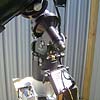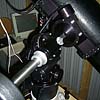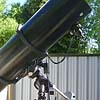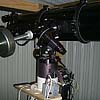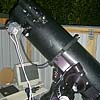Equipment & tools
Here is a list of the most important parts of my equipment, which i have accumulated over the years:
This telescope has fairly good optics, only drawback is that the mirror cell doesn't hold collimation too well. However, I tend to do a thorough collimation before taking high resolution images of the planets, so it is not a big problem. 50mm finderscope with crosshairs, homemade from an old pair of binoculars. It has excellent optics and my homemade brackets are functioning reasonably well. I'm considering upgrading to a 80mm finder though, so star hopping to faint patches of nebulousity will be easier. Losmandy G11 equatorial mount. My new precision mount arrived in May 2005 and is now installed on top of the pier in the observatory. Earlier I was using a older homemade mount which I purchased second hand in 1992 and later added my own homemade motordrives for the axes, made from simple grillmotors. I also made a parallel port interface to the motors so I could control the scope from a computer. Motorised NGF Crayford focuser from JMI. This is a very big help in getting well focused and clear images. I used to have problems with my old rack and pinion focuser since it was too unstable to maintain the optical axis. Long exposure modified Philips ToUCam Pro webcam. This is a very good webcam for astronomy purposes. The main reason for this is that it has a real CCD chip, instead of the poorer CMOS chips of many webcams. And it can be modified to take long exposures which is essential for deep sky applications. Steve Chambers has pioneered a number of modifications for common webcams, which enables them to take long exposures. TeleVue 5x PowerMate. This little gem magnifies the image like a traditional Barlow lens, but is completely free of chromatic or any other aberrations. This is an invaluable tool for high resolution planetary imaging. Starry Night Pro planetarium software. This is my main tool for locating objects in the sky. With support for live download of star data it contains a combined 500 million stars down to magnitudes around 20. The STScI Digitized Sky Survey is invaluable for producing photograpic finder charts for the fainter objects. When I'm hunting objects fainter than what I can see with the naked eye in the telescope, I always download a 1 degree x 1 degree image of the object so I'm sure of the exact location and what to look for. Uranometria 2000.0, an excellent star atlas which includes all of the NGC objects. It only covers stars brighter than magnitude 9.5 so I can't use it to locate the most exotic and faint objects such as high redshift quasars. I always use my laptop computer with planetarium software now, but Uranometria is still a nice atlas to browse from time to time, many of the maps are true pieces of art just to look at. Go back to Astrophotography |
